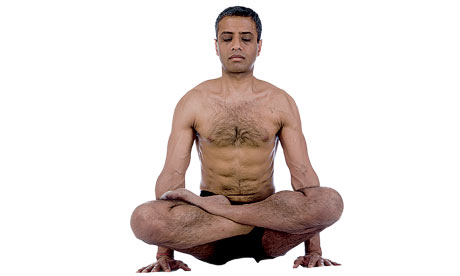
Christos Christophy flips his right leg behind his neck, lifts his left leg and his gaze to the ceiling, and balances squarely on his palms. It's the classic ashtanga yoga pose: knotted limbs, astonishing strength - and a serene smile. For those of us who can, at best, manage a lacklustre downward-facing dog, it's eye-watering.
Six days a week, Christophy rises at 4.30am to start his yoga practice at home, then heads to a class at 7am, practising for a further hour and a half. He's been studying ashtanga for nine years, yet still has to master a further three "series" of poses (asanas) out of a total six. "There's always more to learn," he says.
Ashtanga is one of the best-known styles of yoga - the hot, sweaty "power" yoga - and has been embraced by millions of westerners seeking sculptured arms and a toned bottom. But for serious students, it's a route to living a more balanced life with a strong core, physically and emotionally. "Yoga doesn't suit vain or aggressive people," says Christophy. "You have to be brave. Deep-rooted fears can come up. I've seen people cry during class."
"A challenging pose can be emotional," agrees China Moo-Young. "Often the spiritual side gets to you without you realising."
Ashtanga was introduced to the west from India by Sri K Pattabhi Jois - or Guruji - now 93. At the age of 12, Jois started studying with the guru Krishnamacharya who, in the early 20th century, revived the millennia-old practice of yoga. Jois visited California in 1975, and America was hooked.
Jois's six series of poses are the ashtanga practised today. He believes you must master each pose before you can proceed to the next (the only person certified to practise the sixth series, apart from himself, is his grandson). "The more you do, the more you realise how little you know," says Philippa Asher, one of only two people in the UK certified by Jois to teach the primary, intermediate and advanced series.
Amjad Ghori works for a French bank, advising clients on billion-pound energy projects. Yoga gives him peace and focus: "I lost a 10-year- old daughter, and yoga has helped me make sense of it." Do many bankers practise yoga? "You'd be surprised. They just don't admit it."
Despite its image as a female activity, many advanced students are men, says Asher. "Their strength helps with the harder poses. At least half my class is male."
As a film set designer, Chris Kitisakkul travels regularly. "Yoga is my constant. If you miss it one day, well, it's like forgetting to brush your teeth." Jacqueline Scott, a lawyer with Flo-Jo nails, loves "the sweat and stretch. I'm a converted gym bunny." Scenery builder Peter Buckley took up ashtanga four years ago. "Friends have noticed I'm more open and relaxed now," he says. Daily devotion can get in the way of real life, though. "I'm usually in bed by nine."
For ashtanga devotees, a spell in Mysore, south India, to learn with Jois and his offspring is de rigueur. Asher has been 10 times. "They make sure you're not too obsessed with the yoga asanas and that you honour the other aspects of the ashtanga practice - the stuff you can't see."
"A colleague once remarked, 'There's more to life than yoga'," says Gunveer Mahandru, who practises every weekday. "I said, 'There's actually more to yoga than life'."

